 |
|

|

| TABLE of CONTENTS
 |
2024 Governor's capital budget recommendations include more than $77 million for transportation |
By Doug Mack
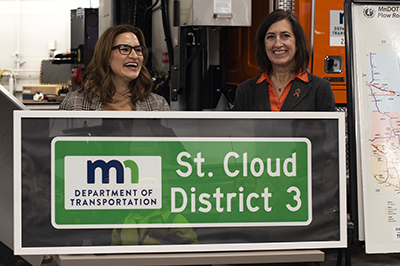
Lt. Gov. Peggy Flanagan and Commissioner Nancy Daubenberger spoke at an event at the District 3 headquarters in St. Cloud in January. The 2024 capital budget recommendations include funding for improvements at several MnDOT facilities, including this one. Photo by Rich Kemp |
The 2024 legislative session is underway, and with it comes a fresh round of talks about the state budget and funding priorities. Gov. Tim Walz’s 2024 capital budget include than $77 million for transportation, with the high priority bridges ($40 million recommended) and MnDOT facilities improvements ($20 million) at the top of the list.
Additional items include a new drainage asset management program, replacement of highway railroad grade crossing warning devices, truck parking safety improvements and the Port Development Assistance.
The Governor’s operating budget requests will be released sometime in early to mid-March. |
| |
|

|
 |
TABLE of CONTENTS
 |
Solar snow fence pilot project first in Minnesota |
By Anne Meyer
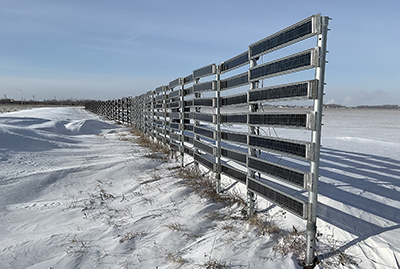
The solar snow fence pilot program is already showing promise. Photo by Dan Gullickson |
Along a well-known windy section of Hwy 10 east of Moorhead is a unique research project that may bring a new energy source into the equation. MnDOT teamed up with North Dakota State University to test the potential for structural snow fences to go solar.
Last summer, NDSU research crews installed a new section of fencing running 100 feet long, with a series of six-inch-wide solar panels on each rung, directly next to an already existing and successful structural snow fence. This project hoped to answer two key questions: Could solar snow fences perform as well as the traditional structural snow fence at trapping snow? And would these small solar panels, which do not move with the sun, generate energy?
The answers seem to be yes on both counts. The solar snow fence did what it should, control blowing and drifting snow, and also provide its worth in terms of energy production.
“The test section created enough energy to power one typical household, and that’s pretty-eye opening,” said Dan Gullickson, blowing snow control supervisor. “If we expanded that to one mile of snow fencing, it would be 50 homes.”
Research is early and there are many new questions being asked. Currently the newly created solar energy powers heating pads on site, which could be another potential benefit when snow drifts get too large. But the best method of getting this energy into the grid has not yet been determined.
Some of those questions may take years to answer, but the pilot project is showing promise.
“You could have snow fences that are actually producing power, producing revenue,” Gullickson said. “I think the future is bright. These solar snow fences could be beneficial for the environment as well as helping improve the safety and mobility of the traveling public.”
The solar snow fence research project will wrap up in June and a full report is being prepared by the team. Gullickson says this research implementation project could inspire investment from partners interested in keeping snow drifts off highways and producing solar energy. |
| |
|

|
 |
TABLE of CONTENTS
 |
Clean Transportation Standard work group submits final report to legislature |
By Shannon Engstrom, Office of Sustainability and Public Health
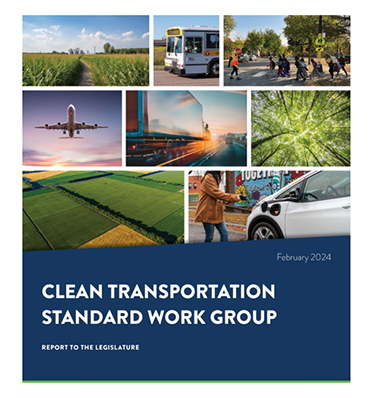
Cover of the CTS report submitted to the Minnesota Legislature. |
MnDOT has partnered with the Departments of Agriculture and Commerce and the Minnesota Pollution Control Agency, to convene a work group tasked with considering how Minnesota would implement a Clean Transportation Standard, also known as CTS.
As directed by the 2023 Minnesota Legislature, the 40-person work group met nine times and held five webinars between July 2023 and Jan. 2024 to review and discuss future scenario modeling and discuss various aspects of implementing a CTS in Minnesota. Their findings and recommendations to the legislature are summarized in a legislative report recently published on Feb. 1. The next step is for the legislature to consider their findings and discuss during the spring 2024 legislative session.
A CTS is a fuel-neutral policy that would incentivize all fuel producers and utilities to reduce the carbon intensity of the production, shipping and use of their fuels. A CTS would be the largest single policy to reduce transportation emissions in Minnesota and would help to achieve the reduction targets for greenhouse gases in the state's Climate Action Framework. It would also support the emission reduction goal in the Statewide Multimodal Transportation Plan and aligns with strategies in the Pathways to Decarbonize Transportation report.
More information about the work group, the policy and a copy of the report can be found on the CTS work group webpage. If you or your office are interested in learning more about the Clean Transportation Standard, please contact Shannon Engstrom, CTS director, Office of Sustainability and Public Health. |
| |
|

|
 |
TABLE of CONTENTS
 |
Office of Administration mourns loss of AnneMarie Burgess |
By Doug Mack
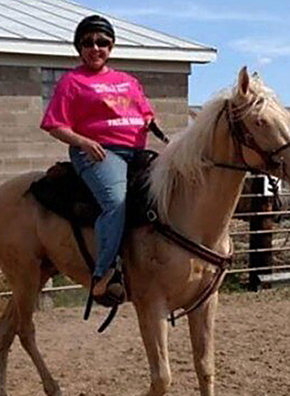
AnneMarie Burgess |
AnneMarie Burgess, a member of the Office of Administration who managed the Projects and Mobile Technology Team, passed away on Feb. 3. She was 61 years old.
“AnneMarie touched so many lives during her time at MnDOT and approached her work and everything in her life wholeheartedly,” said Jocelyn Stein, one of her colleagues in the Office of Administration. “She was especially passionate about advocating for children and animals, and was a true champion. AnneMarie is deeply missed by all who had the honor of knowing her.”
Burgess joined MnDOT as a training and development specialist in District 7 in 2012, after many years of private and government sector work in information technology. In 2015, she began working on MnDOT’s Wildly Important Goal (also known as WIG) of Enhancing Financial Effectiveness and built out a network of coaches across MnDOT’s districts and Central Office to help the agency progress in financial effectiveness, customer trust and other key goals and strategies. Burgess joined the Office of Administration in 2018 as the manager of special projects and mobile technology.
“I’ve had the good fortune to have worked with and for AnneMarie since she started her career at MnDOT,” said Wade Adams, another colleague of Burgess in the Office of Administration. “I can definitely say she had a tremendous passion for the work she did at MnDOT and her legacy will continue on through the programs and processes she help build and establish. As someone who has worked several years for her, one thing that stands out above all about AnneMarie was her unwavering dedication to growing and advancing the careers of her employees. She will truly be missed by our office and everyone who has had the chance to work with her.”
Burgess is survived by her mother, Ethel; children Tyler (Jennifer), Nick (Chelsey), Garrett (Felicia), Kyle, Kelsey (Don) and Lynsey; 10 grandchildren; siblings Tami, Jodi (Paul), and several nieces and nephews. She is preceded in death by her father, Steve.
A celebration of life service was held on Feb. 8 at Janesville United Methodist Church. |
| |
|

|
 |
TABLE of CONTENTS
 |
Molly Short, Greg Olson eligible for vacation donation |

Molly Short |
Molly Short, in the Office of Land Management, is now eligible for the state vacation donation program.
Short has been a state employee since 2006. In March 2023, she was diagnosed with multiform glioma, also known as glioblastoma, a brain tumor, and had to have surgery. She is currently undergoing chemotherapy. As a result of this life-threatening illness, Short has exhausted all sick and vacation leave accruals.
Short has been approved for the vacation donation program and would greatly appreciate any donations she would receive. Any state employee who accrues vacation may donate up to 40 hours per fiscal year, which will allow Short to maintain her salary and health benefits.
Greg Olson, a transportation generalist in District 2, is also eligible for the vacation donation program, as discussed in a Note Mailer sent on Feb. 2.
To donate vacation time, log in to Self Service Portal using your employee ID and password and follow these instructions:
- Select the Benefits tile > My Leave tile. From the menu on the left-hand side, select the arrow to access the Leave Donation/Input Your Leave Donations
- Select the magnifying glass next to “Reserve Bank” and choose (recipient)’s name
- Enter the number of hours you wish to donate
- Select “Save”
- Refer to the Leave Donation Instructions, as needed
Donation forms are also available from your Human Resources Office. |
| |
|

|
 |
TABLE of CONTENTS
 |
MNIT announces new auto deletion process for files in Downloads folder |
By Jeremy DePew, MNIT
Minnesota IT Services (MNIT) is implementing an auto-delete process for files in employees’ Downloads folder. This process will become effective March 6, 2024, for all state employees.
Any file in an employee’s Downloads folder that hasn’t been opened for at least 30 days will be automatically deleted. This new process will improve our data security and free up computer memory space.
The Downloads folder is never backed up, so once files are deleted, they cannot be recovered.
About the change
This automatic deletion process takes effect March 6, and will be ongoing for any files that are downloaded.
This will keep workstations in good functional order, clean up systems, free up valuable storage space and remove security vulnerabilities from workstations.
The automatic deletion process requires a change to the way you use your Downloads folder. The Downloads folder is intended as a temporary location for downloading files. It is not a secure storage method. Downloaded files that are intended for future use should be saved by moving them to a secure location.
What you need to do
- Act now: If you have files in your Downloads folder that you want to retain for future reference, move them immediately to your shared OneDrive or another secure location.
- Going forward: Create a new habit to manage your downloads. After downloading a file to your Downloads folder:
- If you want to save the file, immediately move it to a secure location for retention.
- If you don’t want the file, delete it, or move it to the Recycle Bin on your desktop.
- If you leave a file in your Downloads folder, it will be deleted if you have not opened it for 30 days.
- Learn more: For more information and FAQs, visit the MNIT Connect Extranet.
Options for saving files
- If you have files in your Downloads folder that you need to keep, move them to an approved storage place.
- Storage options include SharePoint, OneDrive, shared drives for your team, and the Documents folder on your computer.
- If you don’t know the approved storage location, please ask your supervisor or manager.
- To move files from your Downloads folder:
- Select the folder icon in the taskbar at the bottom of your computer screen to open the Explorer window.
- Under This PC in the left navigation menu, select the Downloads folder.
- Select the file you want to save and either “drag and drop” it to a new secure location, or right click on the file and choose an option from the drop-down menu.
Deletion process
Effective March 6, 2024, any files remaining in your Downloads folder that have not been opened for 30 days or longer will be deleted automatically.
You do not need to take any actions for the new file deletion process to be in effect on your computer.
Why this is important
- Files stored in the Downloads folder create potential security and data management risks.
- This process will reduce those risks from your device.
- This process will free up valuable memory space on state devices.
Questions or support for technical issues
Review the FAQs on MNIT Connect Extranet. If you have additional questions or concerns, please contact your manager or supervisor or the Legal Counsel at your organization. |
| |
|

|
 |
TABLE of CONTENTS
 |
New library materials now available |
By Madeline Kuncio, MnDOT Library
The latest issue of New Library Materials is available. This month’s collection close-up book is “Killers of the Flower Moon: The Osage Murders and the Birth of the FBI,” by David Grann, which was a MnDOT staff recommendation.
New Library Materials is a compilation of resources added to the library collection during the previous month. Visit our Stay Current page and click New Library Materials to sign up. Questions and feedback are welcome at Ask a Librarian. |
| |
|

|
 |
TABLE of CONTENTS
 |
On the Job: Mike Ehlert makes sure stripes and signs are in good shape |

Mike Ehlert |
By Doug Mack
Road stripes and signs are essential parts of our infrastructure, but so common that they often blend into the background of life, guiding us even if we’re not really conscious of it. Mike Ehlert and his colleagues, though, are always thinking about them and focusing on the little details to make sure these roadway elements are properly crafted and maintained.
How long have you been at MnDOT and in what roles?
I started in 1996, as a highway maintenance trainee. I did that for a year and then shortly after that, they switched the highway maintenance worker classification to the transportation generalist. And then at some point, probably in the early 2000s, I transferred to what is now called traffic services, putting signs up on the side of the road. I became a supervisor at traffic services in 2011 or 2012, and then in 2018 or 2019, I got a job supervising all of our statewide stripers. About a year ago, I got my current position managing the Oakdale state sign shop and our statewide striping.
When you're painting stripes, how are you making them so perfectly aligned on the edge of the road or the lane?
We mostly do maintenance, so we’re retracing what’s already there. But once in a while, there’s a stretch of road where they did a bunch of patching and covered up all the lines or did, say, a quarter-mile overlay.
On the front of the striping truck there’s a guide off the front bumper—it looks like a pole with one wheel on it. Some of the newer trucks have cameras. If they’re working on concrete with seams, they can follow the seams. Just they're running at about 12 miles an hour and they driver will just drive a nice straight line. If there’s no steam, someone has to physically go out there and make little tiny marks on the road for us to follow.
Once you’ve been doing it for a while, it's pretty easy to keep a straight line. The guys doing it are awesome.
How many people are working at the sign shop and what are their various duties?
We have five total employees at the sign shop. Jeff is the supervisor, and he also designs the signs and cuts them on a plotter or digitally prints them on vinyl. Then we have three fabricators. They're the ones who take what Jeff designs and put it onto blank sheets of aluminum. There's multiple steps, but at a high level, that's it. Then we have a guy who does inventory and shipping and receiving. He also orders all of our aluminum blanks, all of our material, all of that kind of stuff.
On average, we do about 60,000 square feet of signs per year.
What are the most challenging and rewarding parts of your job?
One challenge right now is finding striper operators.
We have five latex trucks and two epoxy trucks, and that's what takes care of the whole state of Minnesota. They basically live out of a hotel room four nights a week and work 15- or 16-hours a day, all summer long. We’re having a hard time finding people who are willing to have that level of commitment. So that’s always on my mind: Will we find the people to do these jobs? And if we don’t, we might have to get the work done with a contractor, but that costs the taxpayers a lot more money.
One rewarding thing with stripping is that you almost make a new road look new again by putting new paint on it, and those stripes really help people. For example, there are studies showing that just switching the width of the edge lines can save lives. And it’s a similar rewarding feeling with the signs. When you put up all new ones, it makes a difference. People take them for granted but signs are so important for safety and just finding your way around.
Is there anything about your job that might surprise other people either inside or outside MnDOT?
Most people don’t know that we run these like businesses—we don’t get any funding. The way we pay the bills and keep the doors open is that we charge the districts. We have a certain price per square foot for signs, and then depending on the product we’re putting down to paint stripes, we have different prices per foot.
So for example, we’ll get a work plan for a district, and they’ll ask us to stripe these roads between this reference point and that reference point. And then at the end of the year, I send them an invoice: this is how many feet of paint we put out for you, this is how much you owe us. Or they’ll send an order for 10 or 20 or 30 signs and then we invoice them.
What are your interests or hobbies and outside your work at MnDOT?
I have an 11-year-old and a 15-year-old and they both play traveling soccer, so I’m very busy with that. I like riding my bike and exercising, and in the winter, I do a little bit of cross-country skiing. I also do a little bit of traveling.
Do you or a co-worker have an interesting job to share with readers? Send us your ideas, and we’ll contact you for more information.
Recent employee profiles:
|
| |
|

|
 |
TABLE of CONTENTS
 |
VERG, MnDOT staff support departure of 34th Infantry Division |
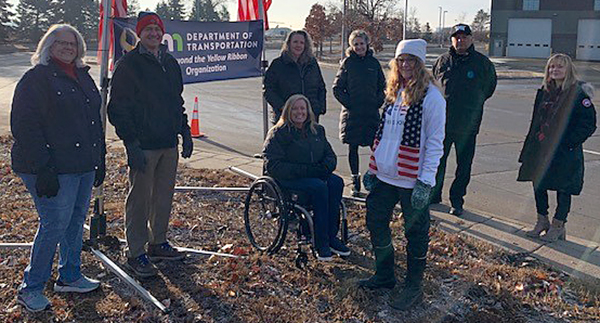
On Feb. 4, members of the 34th Infantry Division of the Minnesota National Guard headed out on deployment to the Middle East. MnDOT Metro District supported the troops by providing a vehicle escorts for five convoys of troops as the moved from their Headquarters in Arden Hills to their plane at the Twin Cities Airport. The Veterans Employee Resource Group hosted a send-off event for the departing soldiers at the Cedar Street Truck Station. The group includes several MnDOT employees, including Heidi Bryand, from the Commissionerís office, whose son deployed with the group. Submitted Photo
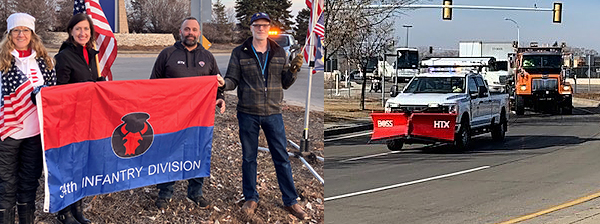
|
|
| |
|

|
 |
TABLE of CONTENTS
 |
Upcoming Lunch and Learns focus on Disability Inclusion Awareness, Mapping Prejudice |
By Doug Mack
Two upcoming Lunch and Learn sessions hosted by Employee Resource Groups offer opportunities to learn about accessibility, history and more. Both events will be held virtually on Teams.
Lunch and Learn with Kirsten Delegard and Michael Corey of Mapping Prejudice
- Feb. 27 from noon to 1:30 p.m.
- Hosted by the African American ERG and the State of Minnesota GIS (GIS Bytes) Collaborative
Since their first presentation to MnDOT in 2021, Mapping Prejudice has more than doubled their interactive geographic compendium of racially restrictive covenants to include both Ramsey and Dakota counties in addition to the original Hennepin County release. Project Director Kirsten Delegard and Geospatial, Technical and Data Lead Michael Corey will visit MnDOT to speak on the project’s expanding scope, insights gleaned from more than seven years of exploration and analysis, and their evolving outreach, collaboration, and education efforts.
Disability Inclusion Awareness training Lunch and Learn
- March 6 from noon to 1 p.m.
- Hosted by Strategic Women Advancing Transportation (SWAT) and Fully Utilizing Employees without Labeling (FUEL)
The event is designed for recruiting, hiring and managing employees and workgroups interested in increasing their diversity inclusion knowledge and skills. The session is a safe place to learn and talk about disability topics, including:
- Disability statistics, myths, etiquette, historical perspectives and communication tips
- The Americans with Disabilities Act (ADA) and how a disability is defined
- Practical steps for complying with ADA, supporting disability disclosure and providing reasonable accommodations
If you have any questions about the March 6 event, please contact Chris Ward.
Join the March 6 Lunch and Learn on Teams.
Closed captioning is available for both Lunch and Learn events. To learn more about Employee Resources Groups, visit the ERG page on iHUB or contact Frida Alvarez.
|
| |
|

|
 |
TABLE of CONTENTS
 |
James Cownie completes Senior Leadership Institute |

Jim Cownie Photo by Rich Kemp |
By Doug Mack
MnDOT Deputy Chief Counsel James Cownie recently completed the Senior Leadership Institute, a 10-session executive development program presented by the University of Minnesota’s Hubert H. Humphrey School of Public Affairs.
Each program cohort includes 30 senior state officials, selected competitively; Cownie was the only MnDOT participant for this cohort.
“SLI provided a great opportunity to refine my leadership skills to be the kind of leader the state will need as we confront the challenges and opportunities of the future,” Cownie said. “I learned that many state agencies share the same concerns as MnDOT and it was great to learn from leaders in other agencies and to share what MnDOT is doing.”
|
| |
|

|
 |
TABLE of CONTENTS
 |
Kids across Minnesota participate in Walk, Bike & Roll Day |

Helped along by unseasonably warm temperatures throughout much of the state, students from more than 60 Minnesota schools, including these girls in Minneapolis, participated in the winter edition of the Walk, Bike & Roll Day. Submitted Photo |
|
| |
|

|
 |
TABLE of CONTENTS
|
Name That Place Puzzler #19 |
By Doug Mack
Can you name the place pictured below? The ground-level photo is from Google and the satellite image is from the 511 website and app. Hint: look at the calendar.
If you think you know the answer, email Newsline editor Doug Mack. The first three people to submit the correct answer will receive the fame and glory of having their names listed in the next issue of Newsline.
Answer to the last Puzzler: Main Street (Hwy. 59) in Marshall. The first people to get it right were Jeremy Erickson (District 4), Chelsey Brummer (Office of Materials & Road Research), Bri Raftevold (Project Management & Tech Support), Micah Holzbauer (Office of Materials & Road Research) and Patrick Gilbertson (Office of Land Management). Congrats to them and thanks to everyone who played!
|
 |
|
|
|



